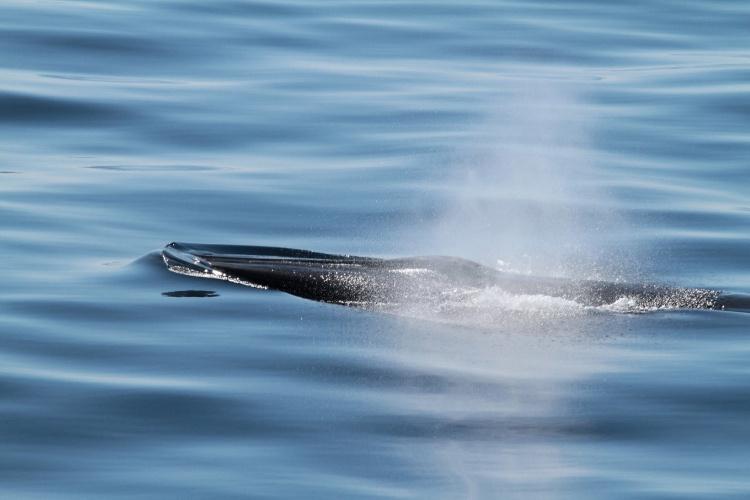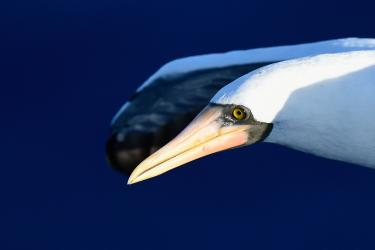Gulf of Mexico Bryde’s whales (GoMex Bryde’s whales) are the only resident baleen whale in the Gulf. They are also among the most endangered baleen whales in the world. Scientists are now turning to new technologies to study them in their natural environment.
With an estimated abundance of only 33 animals, these whales typically are seen within a small area of the northeastern Gulf of Mexico. The reasons why this population has such a low abundance are unclear as we know little about these whales. We currently have limited information about their foraging ecology and habitat requirements. Questions remain about their current distribution in U.S. and southern GoMex waters.
The U.S. waters of the Gulf of Mexico are highly industrialized. GoMex Bryde’s whales are exposed to threats from human activities such as:
- Shipping
- Pollution
- Energy exploration and production
- Gear entanglement
- Potentially harmful levels of human-caused noise
These whales were recently listed as "Endangered" under the Endangered Species Act (ESA). Protecting this population is dependent on a thorough understanding of their behavior and habitat, in order to develop sound management approaches that protect them and their environment.
GoMex Bryde’s whales can be difficult to study. They spend little time at the surface, and when they do, they can have faint blows. They show a significant portion of their body only when they are about to dive—known as a "high arch." These behaviors make them difficult to observe in less-than-ideal sea conditions. In general, they do not readily tolerate approaches by the scientific small boat used for biopsy sampling and tagging. These are key components of our research plans for this study.

Faint blow as a Gulf of Mexico whale surfaces in the distance. Note how difficult this could be to see in rough seas, and this is a ‘good blow’ for this species! Credit: NOAA Fisheries (Permit #14450 and 21938)
NOAA has been using small-unmanned aerial systems (sUAS)—or drones—to study large whales, cetaceans and pinnipeds since 2011. We operate with specific authority granted by the Federal Aviation Administration and our Marine Mammal Protection Act research permit. We were joined during leg one by NOAA certified sUAS pilots, Lisa Conger and Elizabeth Josephson from the Northeast Fisheries Science Center.
During the first leg of the survey, we are looking at the viability of using a vertical takeoff and landing camera platform to study this population. The primary objective is to gather high-resolution images from directly overhead while the animals are at or very near to the surface. Using these photos, scientists will be able to estimate morphological parameters (such as length, width, girth, etc.). We can more carefully assess the overall body condition of individual animals. Combined with the other data collected, these assessments may reveal important gaps in the information needed to manage and protect this population.

Elizabeth Josephson prepares to recover the APH-28 after a flight. Research conducted under Permit #21938. Credit: NOAA Fisheries
These initial deployments over select animals have been more successful than initially anticipated. Some bugs were resolved with the camera system and the team learned something valuable with every evolution. Integrating the use of sUAS on future projects will be a valuable tool that dovetails well other visual and acoustic data collection methods to provide a more complete picture of this population.

GoMex Bryde’s whale prepares to surface on a calm day in the northeastern Gulf of Mexico. Credit: NOAA Fisheries/Grace (Lisa) Conger and Beth Josephson (Permit #21938)
*All photos were taken under NOAA research permit #14450-05 and 21938 issued by the NMFS Office of Protected Resources to the SEFSC to the Marine Mammal Program.
** Flying sUAS or ‘drones’ over marine mammals is an activity that may only occur with specific authority. Please do not harass the wildlife!
Meet the Bloggers
Debra Abercrombie
Debra contributed to this blog in a big way but has since taken a position with the U.S. Fish and Wildlife Service.
Tony Martinez
Anthony Martinez is a senior research scientist that has been actively developing and leading scientific expeditions throughout his career with NOAA. Mr. Martinez brings a deep and varied base of experience and a multi-disciplinary skill set to his position. His unique combination of skills and experience has been invaluable in accomplishing many of NOAA's scientific research goals throughout his career.





